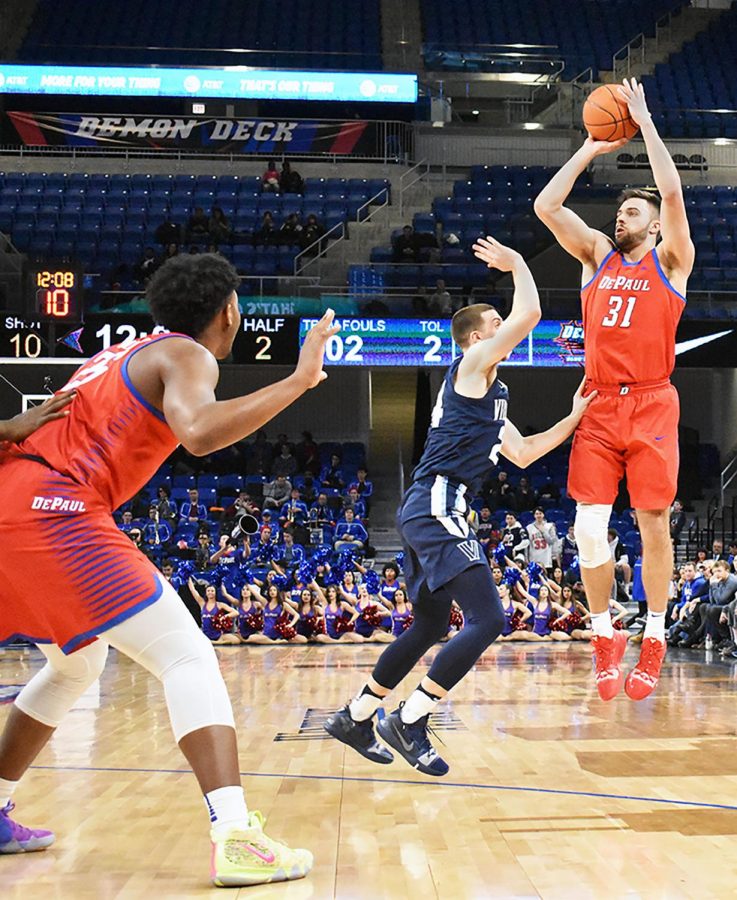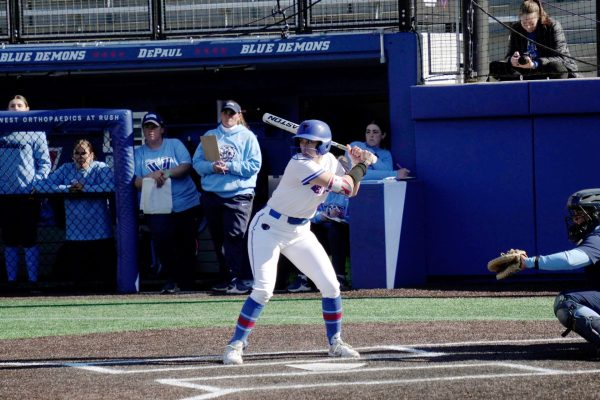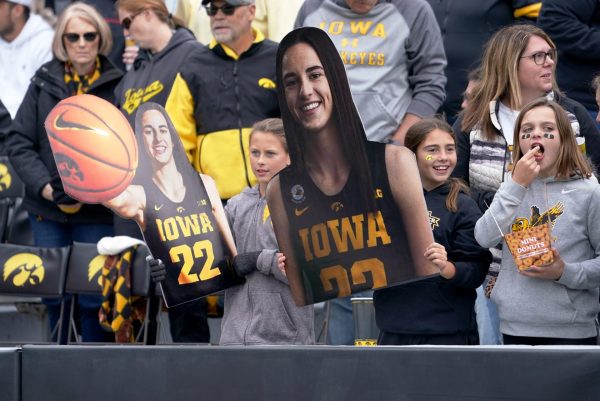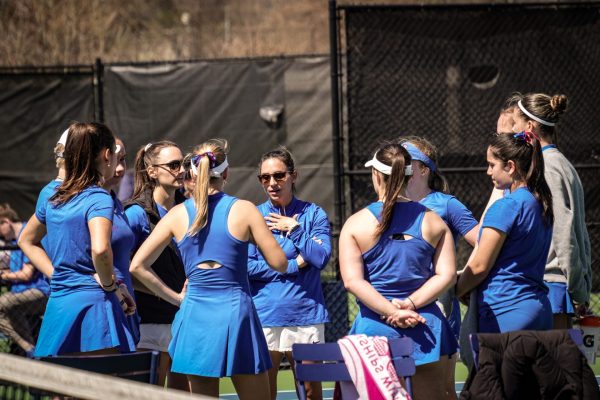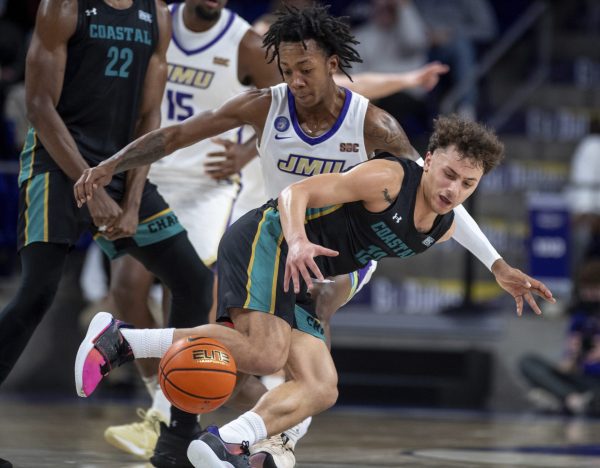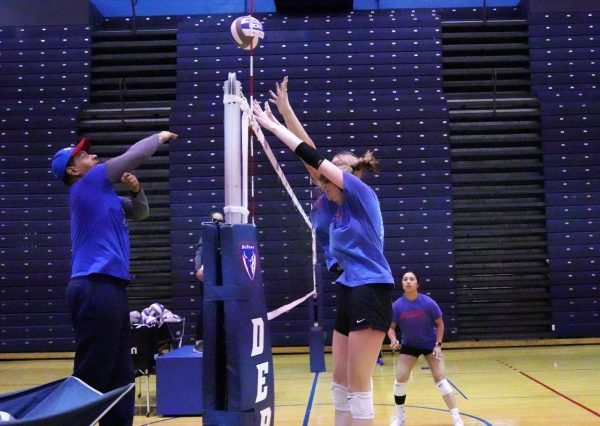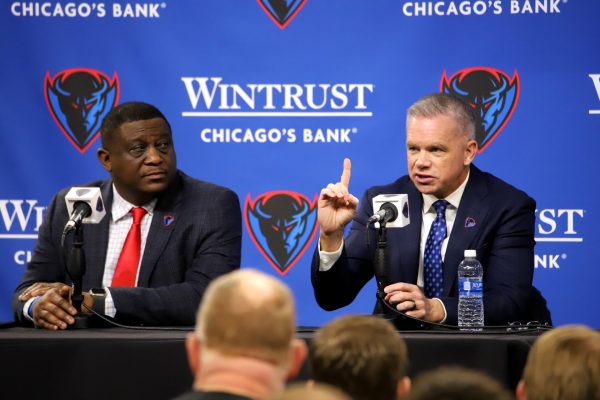Villanova wins out in clash of styles
Andrew Hattersley | The DePaulia
DePaul senior guard Max Strus shoots over Villanova guard Joe Cremo during DePaul’s loss Wednesday night at Wintrust Arena. Andrew Hattersley | The DePaulia
In an era in which 3-point shooting has become the norm in the NBA and is now starting to transition into the college game, some teams are starting to adopt that strategy while other teams are more hesitant to follow which makes it harder for them to win games.
DePaul (12-9; 4-6 Big East) and Villanova (18-4; 9-0 Big East) squared off on Wednesday, and just like the first matchup the Wildcats emerged victorious 86-74, once again sweeping DePaul and extending its winning streak to 18 straight games over the Blue Demons.
The difference in play style was also clear as day.
Just inside the first couple of minutes of the game the Wildcats knocked down three 3-pointers to set the tone of the game. DePaul, which isn’t known to be a 3-point shooting team, had one of its best games from that department, going 7-16 on the night.
However, the difference between the two sides is the volume of 3-pointers they take per game. Villanova ranks first in the conference in attempts and makes, while DePaul ranks ninth in 3-point attempts and 10th in makes per game. So, while the Blue Demons had a relatively good night from behind the arc, they still took 19 less attempts and had eight fewer makes.
“The first 10 minutes of the game, it was the first TV time was 9:09 and they were making really tough shots,” DePaul head coach Dave Leitao said. “But we were guarding them. We could have guarded them a little bit better and that’s what we talked about, so in the start of the second half we didn’t guard them as intensely.
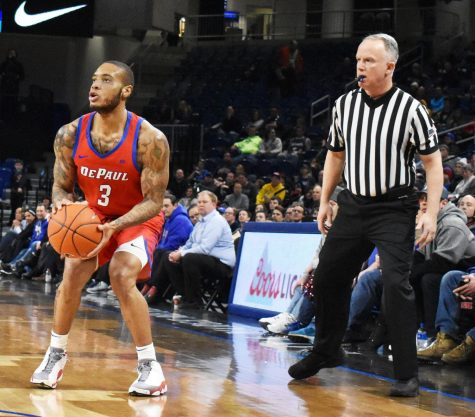
When both teams went into the halftime break Villanova was leading 40-36 after senior guard Eli Cain knocked down a 3-pointer to cut the Wildcats’ lead to four. When the second half started, Villanova came out hot from behind the arc, 24 of their first 29 points in the half came via the 3-point shot, and after nine minutes the lead was 66-53, Villanova.
“Their style is so unique, that they spread you out and play pick-and-roll,” Leitao said after the Villanova game. “It’s like watching an NBA team because they spread you out, the guy rolls and they make a decision from there. So, I thought we were slow to our rotations and then when we changed some things up they took us off the dribble. Those 3’s, early at least, the score standpoint put us behind the eight ball.”
The pressure that Villanova put on an opposing team’s defense with their 3-point shooting is important to their success because in their four losses this season, which all came in non-conference play, the Wildcats never shot higher than 34 percent from behind the arc. In conference play they have only shot below 38 percent twice. In conference play, where they are undefeated through nine games, Villanova has shot over 40 percent five times and have made at least 15 3-pointers three times this season, so it’s fair to use the old cliche “they live and die by the 3-point shot.”
“We know we have really good shooters, but even good shooters miss,” Villanova head coach Jay Wright said. “I thought we took one bad three. The one that Phil [Booth] took at the end of the half he got mixed up with the clock, he was thinking two-for-one. Other than that I thought we took all good threes, it’s a big part of our offensive scheme and we want to take advantage of that.”
For DePaul it’s been really challenging this season to defend the 3-point shot, both in non-conference play and in conference play. In 10 Big East games, opposing teams are shooting 35.7 percent from behind the arc, which is fourth-highest in the conference. In six of their conference losses, five of those games’ teams shot over 40 percent, while DePaul was way below that number. So, against Villanova those same struggles reared its ugly head with the Wildcats shooting 42.9 percent.
In the end, the Blue Demons were unable to contain the 3-point shot, which in the end cost them another conference game.
“I wouldn’t really say it’s hard to guard them, I just think they have really good shooters,” Cain said about Villanova’s 3-point shooting. “If you look, probably 70 percent of their shots were contested, they just made them. You can do different things to guard them defensively, I think we did a pretty good job against them. In the first half we did a pretty good job. They just made contested shots.”
With the Blue Demons not being great at 3-point shooting and not committing to that area, they play an “old school” style of basketball where they usually have two bigs in the game and try to punish the opposing team in the paint. Against Villanova, they had 36 points in the paint and senior forward Femi Olujobi had another strong performance, adding 20 points and eight rebounds.
“I feel like I’m doing the same thing as I was doing early on,” Olujobi said. “In conference play in particular, just spacing and the ability to play one-on-one has been there a lot more. So, I’m just getting a lot more opportunities and I’m putting the ball in the basket at the end of the day.”
Olujobi, alongside sophomore forward Paul Reed, have been dominant in conference play, especially in the last seven games, where both have recorded multiple 20-point games and multiple double-doubles.
So, while DePaul doesn’t play the game the modern style of spreading the floor, attacking the paint and kicking it out for 3-pointers, they still have been able to find success with their size and length inside on offense. However, with eight games left in the season, the Blue Demons are going to need to be better at defending the 3-point line if they want to emerge in a crowded Big East.


